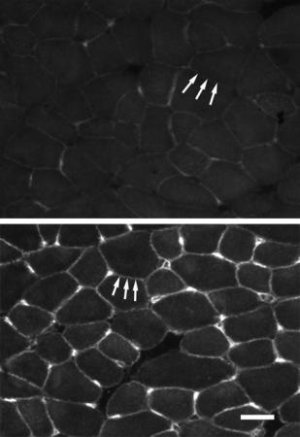Human protein improves muscle function of muscular dystrophy mice
Human protein improves muscle function of muscular dystrophy mice
Now headed toward human trials, biglycan significantly slows the weakening of muscles in mice with the genetic mutation that causes muscular dystrophy. Biglycan causes utrophin, a natural muscle-building protein prevalent in young children, to collect in muscle cell membranes.

Keeping muscles strong Muscle cells of untreated mice with muscular dystrophy (top) show little utrophin in cell walls. Muscles of mice treated with biglycan (bottom) have accumulated the protein utrophin. Credit: Fallon Lab/Brown University
PROVIDENCE, R.I. [Brown University] — A novel potential therapy based on a natural human protein significantly slows muscle damage and improves function in mice who have the same genetic mutation as boys with the most common form of muscular dystrophy, according to a paper published online Dec. 27 in the Proceedings of the National Academy of Sciences.
Duchenne Muscular Dystrophy is a fatal genetic mutation in about one of every 3,500 boys. They are unable to produce a protein called dystrophin that keeps muscles strong. By eight years of age, the boys begin to have trouble walking. By their teens they are often in wheelchairs, and by their 20s muscle function is so degraded that they die.
“This is all aimed at getting a therapy that will meaningfully improve the condition of patients,” said Justin Fallon, professor of neuroscience at Brown University and the senior author of the paper. “This is an important step along that path.”
This fall, the startup company Tivorsan Pharmaceuticals licensed rights from Brown to the key protein, biglycan, hoping to bring the potential therapy through clinical trials.
Biglycan restores the muscle-strengthening presence of a protein called utrophin, which is normally prevalent only in very young children. Utrophin still exists in adults, but in fewer places and not where it can help muscular dystrophy sufferers who cannot produce dystrophin, which keeps adult muscles strong.
Encouraging experiments
In experiments described in the paper, Fallon’s team showed that biglycan delivered to the bloodstream draws utrophin to the cellular membranes of muscle cells. Much as utrophin does when it is present in fetuses, infants and toddlers, the protein works to help the cells build and retain their strength.
In one experiment, Fallon’s team found a 50-percent reduction in “centrally nucleated” fibers in the muscle tissue of biglycan treated mice compared to untreated mice. Biologists recognize the fibers as indicators of recent tissue damage and repair, so a reduction in them suggests that the muscle tissue is suffering less damage.
The team also subjected mouse muscles to a standardized stress test where they are simultaneously stretched and caused to contract. The test ultimately weakens even healthy muscle, but in the tests conducted by researchers and co-authors from the University of Pennsylvania, the muscles of muscular dystrophy mice treated with biglycan lost their strength 30 percent more slowly than similar mice who were untreated.
In more recent tests using an improved formulation of biglycan, Fallon said, the team has seen that figure rise to 50 percent in some muscles, meaning that mice treated with biglycan are holding on to more of their function for a longer time.
Fallon said the effects of treatment with biglycan lasted through months of testing. Several basic tests for side effects during that time frame, such as kidney and liver function, did not indicate any harm from the therapy.
With the efficacy of biglycan apparent in the mouse model of Duchenne Muscular Dystrophy, Fallon is eager to see if it can improve the lives of thousands of children.
“The next big step is testing in humans,” Fallon said.
In addition to Fallon, authors on the paper are Alison Amenta, Atiglan Yilmaz, and Beth McKechnie of Brown, Sasha Bogdanovich and Tejvir Khurana of the University of Pennsylvania, and Mehrdad Abedi of the University of California–Davis.
Funding for Fallon’s muscular dystrophy research came from the National Institutes of Health, Charley’s Fund, the Nash Avery Foundation, and Parent Project Muscular Dystrophy.
* The above story is reprinted from materials provided by Brown University
** More information at Brown University (Providence, Rhode Island, USA)




















